- Home
- Bill Bryson
Icons of England Page 15
Icons of England Read online
Page 15
The footpath involved in that particular excursion ran alongside a huge field – farming in Oxfordshire was being fully intensified at that time, with average field size increasing year on year. In the middle of this field stood a large but not particularly beautiful oak tree, apparently in good health and very hard to ignore. It’s difficult to explain now, but that tree adopted me during the course of that year; and ever since I have been an absolute sucker for solitary mature trees in cultivated fields.
You would be amazed how many there are once you start looking for them. But what are they doing there? A landowner, however many years ago, must have consciously decided to leave that tree totally untouched – perhaps to provide shelter for livestock in fields that had been used for grazing before being converted to arable farming? Or just because? And every one of that farmer’s heirs must have consciously decided that was the way things should stay.
It’s hard to think of a more eloquent snook being cocked at the iron-clad laws of economic efficiency. Every square inch that tree takes up is a square inch not devoted to profit maximization. Every bit of goodness that tree sucks up through its roots is goodness and water lost to a particular crop. Every outing of the drill or plough or harvester will be irritatingly inconvenienced by having to deviate around its immovable presence. By that measure, the more barren and prairie-like the farmed landscape, the more powerful a statement such stand-alones seem to make.
Of course they do provide a return, but in metrics that are currently dangerously devalued. Such trees (particularly oaks) are often host to all sorts of benign predators that help control pest infestations in the surrounding crop – vertical beetle banks, if you like, sustaining an enclave of biodiversity in a monocultural desert. And as far as the local community is concerned, such trees provide continuity and constancy, a small but telling riposte to those who say that the only thing that never changes is change itself.
I only watched my Boars Hill oak through one set of seasonal shifts, but even now I can recall the observance of detail, colour, density and transparency. And that’s the same rhythm – year in, year out – without surprises. I am what I am, such a tree says, so relate to me on my own terms. When I returned, years later, the tree was still there, and although the immediate continuity was broken, the connection continued. Whenever I see trees like these, I feel they are waiting for us to get our act together, pre-eminent genii loci, anticipating the day we humans finally rediscover what it is to be at one with the natural world. Possibly not in my lifetime – but I have no doubt these resolute survivors are somehow telling us that we shouldn’t leave it too much longer.
WHATEVER THE WEATHER
Gavin Pretor-Pinney
on clouds
SAMUEL JOHNSON WAS ALWAYS one for observation. ‘It is commonly observed,’ he once wrote, ‘that when two Englishmen meet, their first talk is of the weather.’ This is still true today, though it is perhaps less remarkable: with the uncertainties of climate change, you can probably say the same about most nationalities.
Some claim that our love of discussing the weather stems from a social unease – that debating the chances of rain before tea merely serves to deflect attention from less anodyne matters. This is a very clichéd and outdated image of the English. The fact of the matter is that we have a lot to say about the English weather because there is a lot of it going on.
The British Isles inhabit latitudes where warm tropical air and cold polar air battle for supremacy, the North Atlantic being their favourite zone of conflict. England is one of the first in line to receive these meteorological skirmishes as they head west. But our island position, in close proximity to the warm waters of the Gulf Stream, also ensures that our winters are much milder than elsewhere at equivalent latitudes.
The unpredictability of the English weather seems, inevitably, to turn our discussions into moans: it is too damp, too cold, too cloudy … Yet the wild, changing, seasonal glory of our weather has shaped the beautiful English countryside. Why do so many of us yearn for the clear blue skies of California, Spain or Australia? They seem to represent, in our collective mind’s eye, not just an idea of paradise, but nostalgia for the endless and cloudless summer days of our childhood. We dismiss clouds; they are brutish harbingers of bad weather and bad times. This attitude has even infiltrated our language. We talk in a derogatory way about someone with their ‘head in the clouds’, or shiver with a sense of foreboding at the prospect of a ‘cloud on the horizon’. ‘Blue-sky thinking’, on the other hand, has more positive connotations.
This is a form of madness. Why must we continue to believe the grass is greener where the skies are relentlessly blue? The English weather has sculpted the contours of our uplands and nourished the mossy woodlands of our valleys; it is as varied as the landscape itself. There is nothing more exquisite than a soft warm day in early May when the hawthorn is heavy with blossom and the grass a lush green from winter rains. What can match the invigorating howl of an autumn gale (especially when you are tucked up warm inside)? Or the muffled crunch of footsteps on a winter morning when the world lies a foot deep in fresh snow?
The clouds of England are not just rain-filled annoyances. They bring beauty to our sunsets, nourishment to our gardens and ever-changing airy sculptures to our skies. our clouds are ethereal, majestic works of art that are also the most egalitarian of nature’s displays, available to us all. Everyone has a ringside seat and you don’t have to live in an area of outstanding beauty to appreciate them.
The Victorian critic John Ruskin said, ‘For me, nothing has ever rivalled the variety and drama of clouds.’ These free displays of abstract art, so much a part of the English climate, are something to be celebrated.
HOLDING BACK THE SEA
Libby Purves
on harbour walls
GIVE THANKS AND PRAISE for harbour walls. This is a rugged island, and though it has some fine natural harbours guarded by rocks, especially in the west, it is the unsung industry of generations which has made our coast safe for the sailor. Quays and breakwaters, stone and cement, artful shapes devised with local cunning to hold away the storms and swells: these are not just picturesque. To those who will listen, their stones sing of patient ingenuity and heroic carefulness; a quiet legacy from a harder-working age.
For the casual stroller, a stone pier or seaward promenade is merely a convenient bit of scenery: mossy, salty, a place to admire fishing boats and defy the waves. You sit of an evening on a worn old bollard, and hardly recognize how brilliantly placed a warping point it was, for turning the old sailing ships before the age of power.
For the sailor, taking a small boat round the coast, the old harbours spell safety and rest. Look down from the heights of Whitby towards the gallant bulwarks of Whitby harbour, see the cobles chugging in, dodging the shifting banks where the Esk deposits its silt; see the tide go out in Bridlington, and the police horses exercising on the hard sand between the piers. Or look at the curled beauty of Charlestown, the pier at St Ives, the clever basin at Ramsgate, the granite walls of Aberdeen or the rounded masonry of Portpatrick: and as you look, think of their maker John Smeaton, the eighteenth-century genius who was the first modern civil engineer, and who understood the power of water and the needs of boatmen as fully as he knew his materials.
The west is magnificent; but to me it is the east coast harbours which are most moving. They speak of the eternal, humble give-and-take of humanity with the sea: of reaching out into the unknown and hoping for the homecoming. There is something gallant about these little sandy harbours, assisted by few natural features: they have crept seawards, not with the arrogance of the great industrial shipyards but with persistent local determination to defy disaster, raise the money, catch fish, take trade, and give insignificant outof-the-way towns a maritime back door and an identity with the world. Praise them.
DIG FOR VICTORY
Tony Robinson
on Mick Aston
BEFORE I MET MICK Aston, I thought archae
ology was all about treasure hunting, and that an archaeologist’s job involved digging enthusiastically into hillsides, and pulling out skulls and rusty swords. But under his tutelage, my eyes were opened to the fact that our archaeological heritage is an invaluable and irreplaceable part of our landscape – one that should be treated with love and respect.
One frosty morning, early in our friendship, he took me to the top of a church tower in the Welsh Marches. Below us was Much Wenlock, a typical little country town like so many others; the sort of place you’d stop off at to have a trawl round the gift shops, then drive on until you found a pretty country pub with an interesting lunch menu.
But Mick showed me a version of Much Wenlock that the casual tourist never sees. It was what he called ‘the palimpsest of history’ – the way the modern buildings overlaid the Georgian town, which cut through the Tudor plots that lie on top of the Norman street pattern, which itself surrounded a Saxon monastery. He pointed out how the tangle of streets and alleyways had a ruthless logic to them, how each one represented the needs of a particular group of people at a particular time in the settlement’s history.
I could see why the town was built where it is, adjacent to a ford and at the head of a valley – the route between Wales and England for millennia. And beyond all this, I saw that what had initially seemed like a vague jumble of fields and hills were, in fact, medieval field systems, abandoned quarries and fishponds, prehistoric burial grounds and Roman trackways.
The English landscape and its archaeology are under threat as never before from deep ploughing, inappropriate legislation, irresponsible metal detecting, theft, global warming and general ignorance. Mick Aston is a quirky, wise and Rabelaisian champion of our countryside who has inspired a generation of archaeologists (and armchair archaeologists) to look at our landscape as a portrait of change. It is a portrait we must cherish for the sake of future generations. I just wish there were more like him.
SMILING AT THE NEIGHBOURS
Alexei Sayle
on rural friendliness
IN 1984, WITH THE money I made from a hit single, I bought a small house in a village in rural Northamptonshire. I’d been performing the song on Top of the Pops the week before we moved in, and a kid in the village told me that his gran had watched the programme knowing somebody on it was buying Manor Cottage. ‘As long as it’s not that fat one in the tight suit, I don’t mind who it is,’ she’d said.
Our house had a paddock planted with an amazing variety of vegetables by the previous owner, and I was standing in front of a row of carrots wondering how I could use the grass rake I was holding to get them up, when a man started talking to me from the churchyard which adjoined our land. I thought I was prepared for all the unsettling things about the countryside, the silence followed by the sound of things killing other things, the different kinds of trees, the emptiness, the dazzling colours of the wild flowers, but what I hadn’t expected was the friendliness. In London nobody talks to you outside the house – your parents would ignore you if you were in the same Tube carriage together – so I was so thrown by a man I didn’t know talking to me that I flung down the rake and ran inside the house without saying a word.
The next day, my wife and I were walking down a lane when a woman coming towards us wished us a cheery good morning. ‘What’s she after?’ I asked my wife once the woman was out of earshot. My wife explained that the woman wasn’t after anything, she wasn’t planning to rob me or sell me insurance, she was just being friendly for the sake of it, as people in the country were. My wife also said that if I was going to live in the country, I was going to have to learn to be friendly too. This was an entirely new concept for me, but I decided to take it on board. The following day I went for a walk by myself along a disused railway line that ran through the countryside behind our house, determined to try rural friendliness. After about half an hour I came upon a man who was tending a goat that he kept in a sort of lean-to on the other side of the hedge. I strode up to him and with a big smile on my face shouted at him, ‘Nice goat!’ I felt like I was making progress.
PARADISE FOUND
John Sergeant
on Great Tew
THERE ARE SO MANY wonderful villages in England that to pick out one to represent all is clearly unreasonable. But for someone brought up in Great Tew in Oxfordshire, the choice is easy. It is the perfect example of a model seventeenthcentury village estate, with its honey-coloured thatched cottages, its Norman church and splendid pub, the famous Falkland Arms. During my formative years I came to know it as only a child does, with a close knowledge of every fold of the hills, every tree and almost every bush.
In the 1950s, for a small boy interested in climbing trees, setting up camp and shooting at birds with a catapult, Great Tew was paradise. But I could not be as wild as I would have liked because my father was the vicar. In church, we – my brother, sister and I – had to stay for his sermons, while the other children were allowed to leave early. One glorious Sunday, I remember walking through the snow to find that no one else had managed to attend. The church was empty. I was convinced my father would press on regardless, but he read out a single prayer and we were released. I vividly remember that happy day, throwing snowballs and playing with our toboggan in the soft yellow light of a winter sun.
In this Cotswold village, modern life was kept at bay. All three of us went to the primary school on the village green, an easy walk down the hill from home. There was an impressive teacher, Mrs Bury, who lived to see the twenty-first century, dying at the age of one hundred. She taught her thirty pupils in a large schoolroom. We would sit in six rows of desks and we moved up a row at the end of each year. Only rarely did we see a television, and even the stocks on the village green were kept in working order to remind potential miscreants of how they might have been treated in the bad old days.
Our main local town was Oxford. There was a bus once a week, but our family – one of the lucky ones – owned a car and my parents would sometimes take us if, as they later admitted, we were being more of a nuisance than usual. I was only thirteen when we left the Georgian vicarage – just opposite the entrance to the church – for the last time. At that age, it took me a long time to get over the fact that most people did not live in such idyllic surroundings.
Great Tew has changed a lot since I was a boy. It is far more prosperous. Many of the houses which in the past could only be rented by people who worked on the estate – for the miserly sum of £2 a year – have now been sold. Some of the new owners spend their working week in London. In many ways the place has come out of its time warp. But it would still be an obvious contender for the title given to it by a magazine more than sixty years ago: the prettiest village in Britain.
THE BARD’S OWN RIVER
Antony Sher
on the Avon
WE LIVE IN STRATFORD-UPON-AVON for at least half the year; my partner, Greg Doran, works for the Royal Shakespeare Company as Chief Associate Director, and much of my acting career has been spent with them too. We’re lucky. Our apartment is situated right on the Avon. On bright mornings you wake to what looks like a biblical spectacle, causing you to cup your hands over your eyes – the water is ablaze with sunshine, and reflections are playing on the walls and ceilings around you. Swans float or fly by, Canada geese, a heron, the electric-blue glint of a kingfisher. And, in early summer, noisy mobs of seagulls. The eels have arrived. These extraordinary creatures are spawned in the Sargasso Sea, south of Bermuda; they cross the Atlantic to British waters, enter the Severn Estuary, take a right into the Avon at Tewkesbury, progress to Stratford, wriggle up a specially built ramp, the Eel Ladder, on the weir at Lucy’s Mill, and then those who have survived Atlantic perils and Stratford seagulls, finally mate. They then turn round and start on the four thousand mile journey back. Nature must have been drunk when she made them.
Before breakfast, we go for a walk. Within minutes we’re on a rough path on the north bank, a stretch known as Seven Meadows, where t
he spire of Trinity Church quickly retreats into the distance. It never fails to inspire me: the sudden openness of the land, the yellow-brown glow of the river, the tall black shade of the woods opposite. In little clearings at the water’s edge, lone fishermen sit, lost in meditation. I’m from South Africa, and English terrain will always be vaguely unfamiliar, so I rejoice in the fact that Greg (raised in Yorkshire) treats these expeditions as nature trails. ‘Look at all the butterflies today,’ he’ll say. ‘These are cabbage whites, these red admirals, and this – watch as it opens its wings – a peacock.’ We reach the last meadow, Greg’s favourite, profusely overgrown with wild flowers: ‘Here’s the burdock that Lear makes into a crown, here are the long purples that Ophelia weaves into her garland.’
Of course – it hits you again and again – this is where Shakespeare grew up, these are the first things he saw and heard and smelled.
Just after Stanals Bridge we cross to the other bank for our return. Here the views are more spectacular. You’re high above the river to your left, and to your right the horizon is high above you. The world feels tilted, marvellously, yet somehow everything is still upright, whether the holiday barges passing below, with flower pots on their roofs and bemused dogs at their helms, or the farm workers on the field which slopes up to the sky; they’re harvesting a pea crop, speaking to one another in Polish, their voices echoing slightly in the clear morning air.

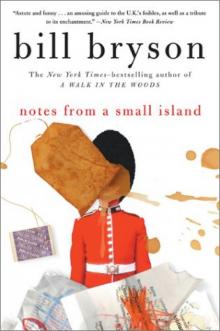 Notes from a Small Island
Notes from a Small Island A Short History of Nearly Everything
A Short History of Nearly Everything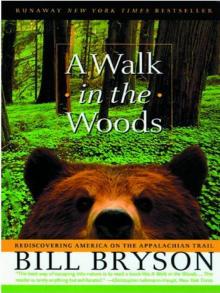 A Walk in the Woods
A Walk in the Woods I'm a Stranger Here Myself
I'm a Stranger Here Myself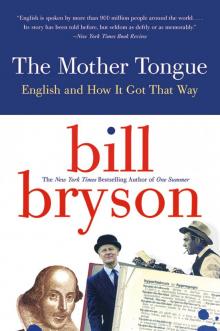 The Mother Tongue
The Mother Tongue Shakespeare
Shakespeare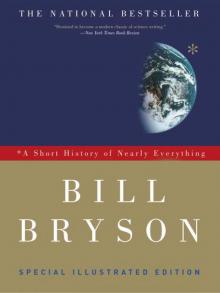 A Short History of Nearly Everything: Special Illustrated Edition
A Short History of Nearly Everything: Special Illustrated Edition The Best American Travel Writing 2016
The Best American Travel Writing 2016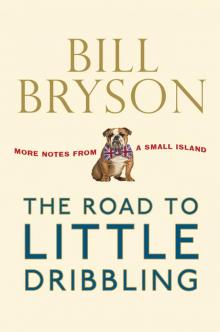 The Road to Little Dribbling
The Road to Little Dribbling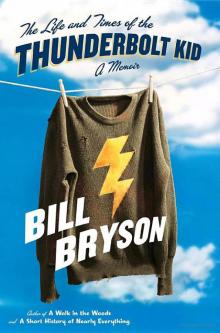 The Life And Times Of The Thunderbolt Kid: A Memoir (v5.0)
The Life And Times Of The Thunderbolt Kid: A Memoir (v5.0) Made In America
Made In America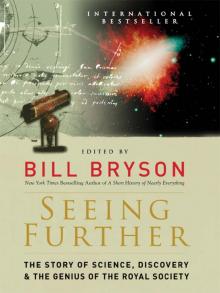 Seeing Further
Seeing Further Shakespeare: The World as Stage
Shakespeare: The World as Stage The Life and Times of the Thunderbolt Kid
The Life and Times of the Thunderbolt Kid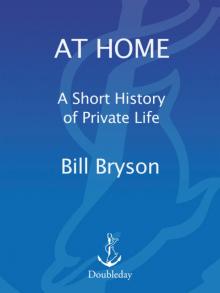 At Home
At Home Bryson's Dictionary For Writers And Editors (v5.0)
Bryson's Dictionary For Writers And Editors (v5.0) Neither Here Nor There
Neither Here Nor There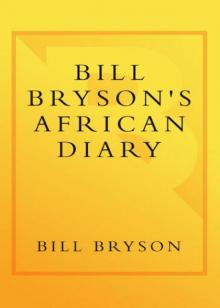 Bill Bryson's African Diary
Bill Bryson's African Diary